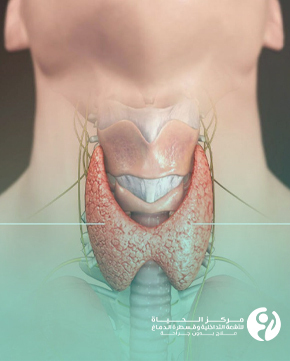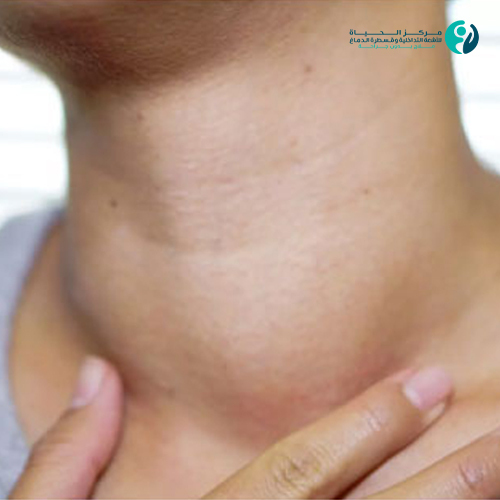
Goiter is a common condition that occurs for a variety of reasons and is often treatable. Interventional radiology is used in the treatment of goiter through precise three-dimensional imaging techniques to destroy the excess tissue in the gland by cauterizing it.
But before we talk about the treatment of goiter, let's learn more about the role of this little gland to realize the importance of treating it.
The thyroid gland is located at the front of the neck and resembles a butterfly in shape. Despite its small size, it plays an important role in regulating many of the body's functions by secreting thyroid hormones that are responsible for multiple body concerns, some are:
- Regulating the metabolism: Thyroid hormones help control how quickly the body burns calories.
- Body growth and development: Thyroid hormones play an important role in the growth and development of the brain, nervous system, bones, and muscles in children.
- Regulating heart function: Thyroid hormones affect heart rate and blood pressure.
- Maintaining a healthy mood: Thyroid hormones play a role in regulating mood and preventing depression.
- Maintaining muscle health: Thyroid hormones help build muscle and burn fat.
Causes of goiter:
Many causes can lead to an enlarged thyroid gland, including:
- Iodine deficiency: Iodine is essential to produce thyroid hormones, and its deficiency can lead to goiter.
- Graves' disease: An autoimmune disorder caused by the presence of antibodies that stimulate the gland to produce excess hormones, leading to hyperthyroidism and enlargement of the thyroid gland.
- Hashimoto's disease: Hashimoto's disease is one of the most common causes of hypothyroidism. It is an autoimmune disease in which the immune system attacks the thyroid cells.
- Nodule formation: The growth of nodules in the thyroid gland can lead to its enlargement.
- Genetic factors: Family history can play a role in goiter.
- Inflammation of the thyroid gland: Inflammation can cause an enlarged thyroid gland.
- Tumors: In some rare cases, tumors may cause a goiter.
Thyroid enlargement in pictures:
The images illustrate the different appearances of goiter and show the prominent changes at the base of the neck due to thyroid gland enlargement.

Symptoms of simple goiter:
Symptoms can vary depending on the size of the enlarged gland and the level of hormonal activity, common symptoms of a simple goiter include:
- A bulge at the base of the neck: It can be visible when looking at the neck.
- Difficulty swallowing or breathing: Especially if the enlargement is significant.
- Hoarseness: Due to pressure on the vocal cords.
- Fatigue and exhaustion: Could be due to an imbalance in the production of thyroid hormones.
- Weight changes: Weight gain or loss can occur based on thyroid activity.
- Dry skin: In hypothyroidism, the skin may become dry and flaky.
- Hair loss: Hypothyroidism can lead to hair loss.
- Cold intolerance: A person may feel cold frequently in case of hypothyroidism.
- Menstrual cycle disorders: Thyroid diseases can lead to menstrual disorders in women.
- Rapid heartbeat: Hyperthyroidism can lead to a fast heartbeat.
- Nervousness: A person may become irritable and nervous in case of hyperthyroidism.
- Tremors: Hyperthyroidism can cause tremors in the hands.
- Dry mouth: In hyperthyroidism, the mouth may become dry.
- Excessive sweating: You may experience excessive sweating if your thyroid gland is overactive.
- Sleep disturbances: With hyperthyroidism, you may have difficulty sleeping.
Goiter in women:
Goiter is more common in women than men because women's bodies are more prone to hormonal imbalances during pregnancy, menstruation, and menopause and are more sensitive to these hormonal changes that affect the health of the thyroid gland and lead to its enlargement. Therefore, women need to monitor their thyroid health and get regular check-ups.
Treatment of goiter:
Treatment for a goiter depends on the type of thyroid disorder, the degree of the enlargement, and the accompanying symptoms. Goiter treatment options include:
Medications:
- Thyroid hormones: Hormone replacement therapy is the main treatment option for hypothyroidism. It involves taking thyroid hormones artificially to replace the hormones not produced by the gland.
- Dietary changes: Eating iodine-rich foods, such as fish and dairy products, is recommended to support thyroid function.
- Antithyroid medications: Used to reduce the production of hormones in the case of hyperthyroidism.
- Iodine supplements: Are used in case of iodine deficiency to optimize thyroid function.
Surgery:
In some rare cases, surgery may be necessary to partially or completely remove the thyroid gland, which may be necessary for the treatment of severe enlargement or the presence of thyroid cancer.
Non-surgical treatments:
- Radioactive iodine therapy: Used to shrink the thyroid gland by destroying some of its tissue.
- Water vapor thermal therapy: This treatment can destroy excess thyroid tissue without surgery.
- Interventional radiology treatment: A new technique that uses interventional radiology to shrink the thyroid gland without traditional surgery. Interventional radiology techniques direct heat or chemicals to the enlarged veins and permanently close them.
Non-surgical goiter treatment:
The focus is now on non-surgical treatments to minimize complications and speed recovery. One of the most common non-surgical treatments for goiter is by interventional radiology, which involves the insertion of a fine needle guided by radiation to destroy the enlarged gland tissue.

Treatment of goiter without surgery at Al Hayat Center using interventional radiology:
Al Hayat Center is a pioneer in the use of advanced interventional radiology for the treatment of goiter, a modern and effective technique that reduces the need for traditional surgery and has several advantages, including:
- Non-surgical procedure: Interventional radiology is a non-surgical alternative to thyroidectomy for an enlarged thyroid gland, a less invasive procedure that avoids the risks associated with traditional surgery.
- Shorter recovery time: Most patients can return to their daily activities very quickly.
- Higher accuracy: Interventional radiology provides high accuracy in targeting enlarged gland tissue without affecting healthy tissue.
- Highly effective: Interventional radiology is an effective treatment in reducing the size of the thyroid gland by 50-60% leading to improvement in symptoms associated with the goiter.
In conclusion:
Goiter is a common condition that can affect quality of life, and understanding the causes and symptoms helps in early diagnosis and appropriate treatment. Treatments range from medications to non-surgical and surgical treatments. Advances in treatment techniques, such as interventional radiology, provide effective and safe treatment options, especially in specialized centers such as Al Hayat Center. Regular follow-up with your doctor remains the key to managing the condition and optimizing thyroid health.



